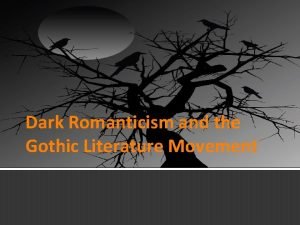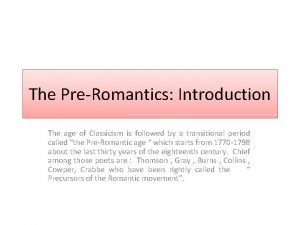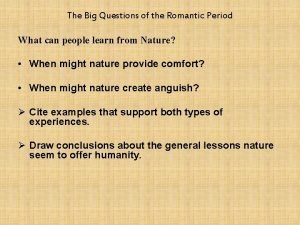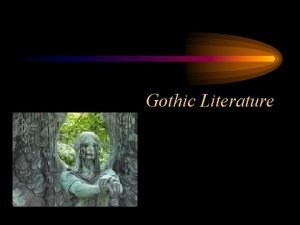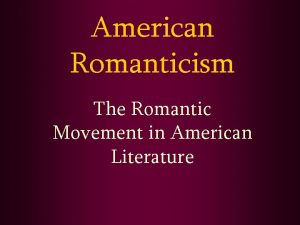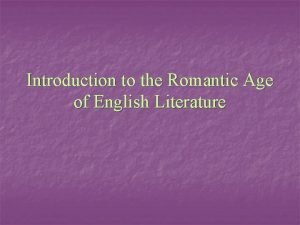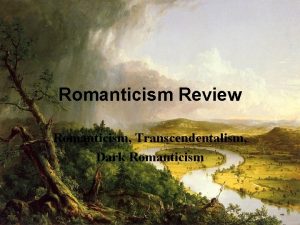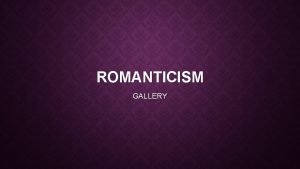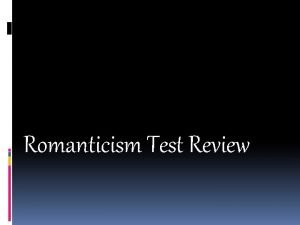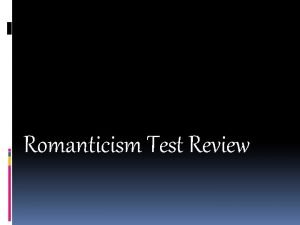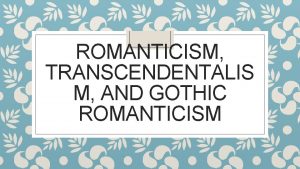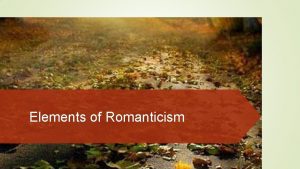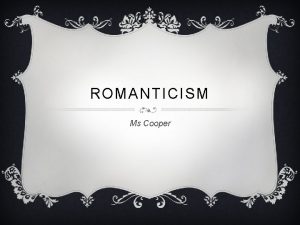Romanticism Romanticism was a movement in art literature









- Slides: 9

Romanticism • • Romanticism was a movement in art, literature, and music dating from the late 1700 s to the mid-1800 s Romanticism is characterized by the 5 “I”s 1. 2. 3. 4. 5. Imagination Intuition Idealism Individualism Interest in nature

Imagination • Romantics emphasized imagination over reason and logic • This was a backlash against the rationalism of the Enlightenment period or “Age of Reason” (16501789) – In the Age of Reason, people believed all truth and knowledge could be discovered through using reason, logic, science, and math.

Intuition • Romantics placed a high value on “intuition, ” or feeling and instincts, over reason • Thus, emotions were hugely important in Romantic art and literature

Idealism • Idealism is the concept that we can make the world a better place • Romanitcs believed that thought (our mind and spirit) makes the world the way that it is; thus, positive thinking actually makes the world a good place (if you think it’s good, then it is) • They were very optimistic about life

Individualism • Romantics “celebrated the individual” • They believed people should listen to their own feelings and their own moral compass to guide their actions and to find what is good and right, rather than just following what society says • They thought people should “march to the beat of their own drummer” • There are no universal truths -- we must search for our own truths!

Interest in Nature • Nature is important because of its sublime combination of beauty and power. • There is something awe-inspiring and somewhat frightening about the natural world.

Gothic Literature • Gothic literature arose around the same time as the Romantic movement (mid-1700 s) • Both Gothic and Romantic writers were reacting to the Age of Reason, and both wanted to free the imagination. • However, Gothics saw POTENTIAL EVIL in the individual, while Romantics saw HOPE in the individual

Gothic Conventions • Setting: – ancient castles, – decaying estates, – weird or haunted places • Plot: – strange and terrifying events; supernatural events – extreme situations (murder, torture, revenge) • These situations bring out man’s true nature, and it is NOT good • Characters: – Supernatural characters like ghosts, demons, and monsters (such as werewolves or vampires) – insane male characters – beautiful women who are dead/dying

Gothic Conventions • Style: – “macabre” ma·ca·bre (adj) • including gruesome and horrific details of death and decay – imaginative distortion of reality – dark atmosphere • Subjects: – the unknown, – the fantastic, – the demonic, – insanity – the human heart and mind – Sin and guilt
 Dark romanticism and gothic literature
Dark romanticism and gothic literature Age of classicism
Age of classicism The romanticism (1795 — 1835) what is romanticism
The romanticism (1795 — 1835) what is romanticism Movement and non-movement area
Movement and non-movement area Differentiate axial movements to locomotor movements
Differentiate axial movements to locomotor movements Romantic era questions
Romantic era questions Gothic vs romanticism
Gothic vs romanticism Primtivism
Primtivism The romantic period in american literature and art
The romantic period in american literature and art Romantic age definition
Romantic age definition
